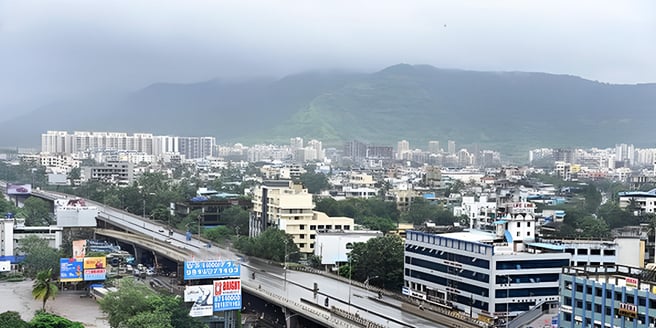Buying a home in Panvel today feels like standing at the edge of a moving train.
You can see it coming, you know it’s going to take you where you want to go… but the doors are closing faster than you expected.
If you’re anything like I was when I bought my first place, your mind is a messy mix of hope and panic.
You’ve probably spent nights scrolling through property listings until your eyes hurt, making Excel sheets for budgets, debating with your partner about “buy now or wait,” and silently fearing that if you wait too long, Panvel will slip out of your reach forever.
I get it — because I’ve been there.
And today, I want to answer your biggest question without the sugarcoating: Is Panvel still affordable for middle-class buyers in 2025?
1. Panvel’s Price Tag in 2025 – Still in the Middle-Class Zone?
Right now, Panvel’s average property rates range between ₹7,000 to ₹11,000 per sq. ft. depending on the pocket, project, and stage of construction.
Here’s where middle-class buyers still stand a chance:
- ₹35–50 Lakh – 1BHK in New Panvel / Pushpak Nagar
- ₹50–70 Lakh – 2BHK in Ghotkampada / Roadpali (outer nodes)
- ₹65–80 Lakh – Compact 2BHK near railway station in Old Panvel
Compared to Kharghar or Vashi, Panvel is still 25–40% cheaper, but the gap is shrinking year by year.
Panvel 2025 Affordability Scorecard
(For a household earning ~₹1 lakh/month, keeping EMIs under ₹35–40K)

How to Read This Chart:
- Two Candles (Configuration) → 1st Candle represent 1 BHK and 2nd 2 BHK.
- Green (Affordable) → well within the comfort budget for a middle-class household.
- Yellow (Stretch Budget) → Possible, but you’ll need to stretch finances or savings.
- Red (Above Comfort) → Likely to strain monthly income and savings.
For example:
- Pushpak Nagar still offers 1BHKs in the affordable green zone (~₹48 lakh).
- Old Panvel is mostly in the red for 2BHKs, making it harder for a middle-class buyer without a bigger budget.
- Ghotkampada offers 2BHKs in the yellow zone, which can work if your income is stable and you’re okay with a slightly higher EMI.
This visual makes it clear that while Panvel is still affordable, your choice of locality will decide whether you stay in the green zone or end up over-stretching.
2. What “Affordable” Really Means for a Middle-Class Buyer
Affordability isn’t just about the base price.
It’s about whether you can buy without crushing your monthly life.
If your household income is around ₹1 lakh/month, you should keep EMIs below 40% of income — roughly ₹35–40K/month.
That gives you a safe budget of ₹45–55 lakh, maybe stretching to ₹60–65 lakh if you have strong savings.
💡 Tip: Always check your “EMI comfort zone” before falling in love with a flat.
3. The Hidden Costs That Can Kill Affordability
Many middle-class buyers make the mistake of budgeting only for the property price. In reality, you should add 10–12% extra for:
- Stamp duty & registration (5–6%)
- GST (5% for under-construction)
- Parking (₹2–6 lakh one-time)
- Floor rise charges (₹20–50 per sq. ft.)
- Society maintenance (₹3–5K/month in premium projects)
These can quietly push a “₹50 lakh home” into the ₹56–58 lakh zone.
4. Infrastructure – Why It Matters for Affordability
You might be thinking, “If prices are going up because of development, won’t I lose affordability if I wait?” — And you’d be right.
Three game-changing projects are already shifting Panvel’s price bracket:
- Navi Mumbai International Airport (NMIA) – Partial operations will push up demand instantly.
- Mumbai Trans Harbour Link (MTHL) – Already cutting commute time to South Mumbai, boosting investor interest.
- Metro Extensions – Closing the gap between Panvel and Navi Mumbai job hubs.
Once these are fully operational, the “affordable Panvel” tag will be history.
5. Commute Time – The Hidden Affordability Factor
A home isn’t affordable if your travel eats into your time and money.
Here’s the real, peak-hour travel picture:
- Panvel → Vashi – 25–35 mins (Harbour Line)
- Panvel → BKC – 55–70 mins (via MTHL)
- Panvel → Thane – 50–65 mins (via Expressway)
If you work in these belts, Panvel still offers a manageable commute compared to Mumbai’s core.
6. Resale & Rental Demand – Your Safety Net
For middle-class buyers, a home isn’t just a roof — it’s a safety net.
- Rental yields in Panvel: 2.5–3.5% annually
- 1BHKs near stations rent faster and easier
- Airport and metro completion will only improve returns
This means even if you move later, your investment won’t sit idle.
7. Builder Credibility – Affordability without Regret
Cheap isn’t always affordable if the builder delays possession or compromises quality.
Stick with developers who have delivered on time in Panvel: Hiranandani, Marathon, Indiabulls, Kalpataru, Wadhwa.
Always check RERA registration before booking.
8. Should You Wait or Buy Now?
Waiting for Panvel prices to fall is like waiting for a cab fare to drop during rush hour — it’s not likely unless there’s an economic slowdown.
- Demand is strong – End-users and investors are both chasing upcoming infrastructure zones.
- Supply is controlled – Developers release stock in phases to keep prices high.
If you wait, you might still buy in Panvel — but with less space, fewer amenities, or further from the city core.
9. Quick Decision Tools for Middle-Class Buyers
Before you book, run these three checks:
- EMI Comfort Test – Can you pay EMI and still save 20% of income?
- Life Stability Check – Is your job, family plan, and location stable for 5+ years?
- Price Momentum Watch – Are new projects selling 70%+ within 3 months? Prices will follow.
My Honest Answer
Yes — in 2025, Panvel is still affordable for middle-class buyers.
But the window is closing fast.
If you fit your EMI comfort zone today, waiting might cost you more tomorrow.
When I bought my first home, it wasn’t perfect — but it was a step that made the next one possible.
Your dream home in Panvel might be the same: a stepping stone that becomes the foundation of your future.
Bottom Line:
Panvel is still middle-class friendly — for now.
The smart move? Decide with both your numbers and your heart before the airport countdown hits zero.


